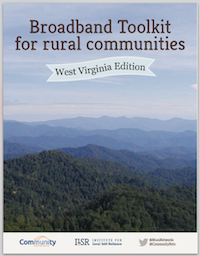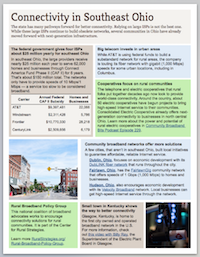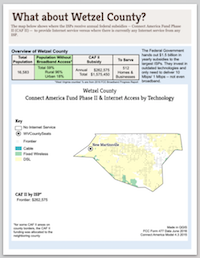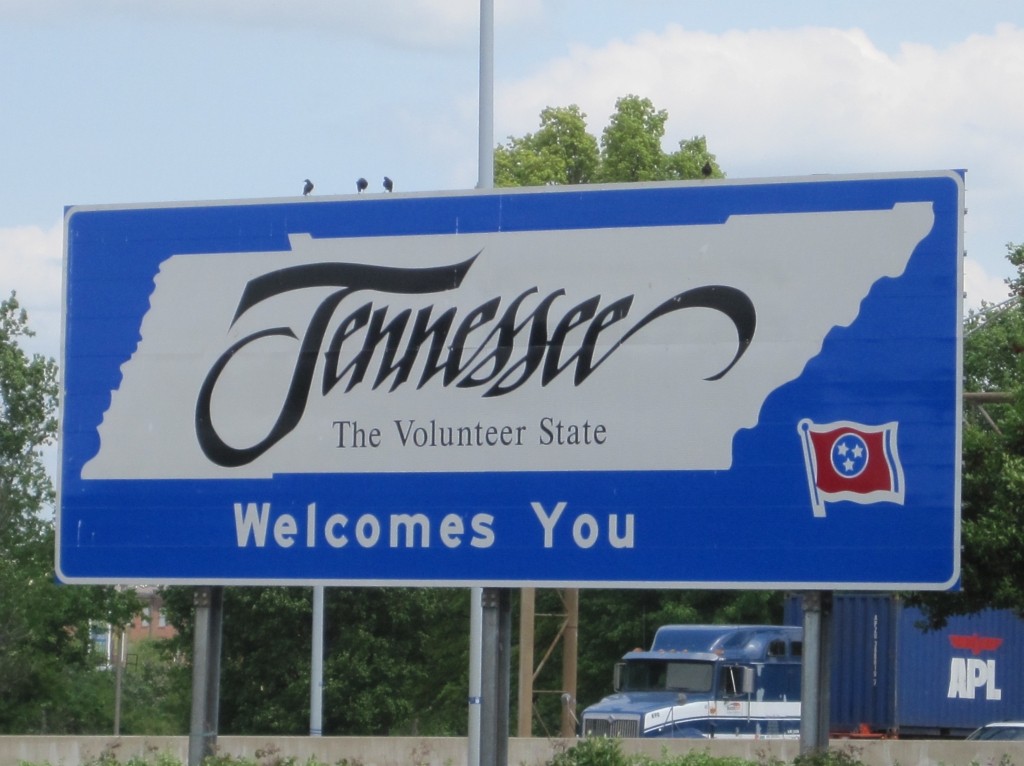Check back on MuniNetworks.org’s Resource Page frequently for updates to Internet access in the Appalachian region.
This is the central hub for ILSR’s research on Internet access around the Appalachian United States. We have compiled federal statistics on broadband availability and federal subsidies for large Internet Service Providers. We’ve created detailed maps of 150 counties in Kentucky, Southeast Ohio, and northern West Virginia.
We’ve also created Rural Toolkits for Kentucky, Southeast Ohio, and northern West Virginia. These toolkits offer a big picture look at connectivity on a regional and statewide level. They also provide action steps for folks to learn more and get involved.
Remember these three key details when reading through this information:
Internet access: if you can get online, check email, and browse the web.
Broadband: the Federal Communications Commission (FCC) currently defines this as speed of 25 Mbps download and 3 Mbps upload.
Fiber-to-the-Home (FTTH): a high-speed fiber-optic connection directly to the home. This type of technology can support speeds of more than 1,000 Megabit-per-second (Mbps).
Appalachia can get better Internet service, but the big companies aren’t going to do it. Cooperatives and small towns are stepping up and delivering world-class Internet service.
Kentucky
 This information covers the entirety of the state – all 120 counties.
This information covers the entirety of the state – all 120 counties.
Rural Toolkit: This toolkit provides the basics of how to get started. From what is broadband to the details of federal funding, this toolkit has got you covered. At the back, it includes a statewide fact sheet, which is also available separately.
Statewide Fact Sheet: Did you know that three Internet Service Providers get more than $327 million to spend on rural Kentucky? Did you know that they aren’t required to build high-speed networks offering broadband?
Information for each county in the state can be found in this Dropbox folder. Each county map outlines where there is any form of Internet access. Then it specifies the technology: DSL, Fixed Wireless, Cable, or Fiber-to-the-Home.
Keep up to date with information about Kentucky here.
Southeast Ohio
 This information covers the counties of Athens, Belmont, Coshocton, Gallia, Guernsey, Harrison, Hocking, Jackson, Meigs, Monroe, Morgan, Muskingum, Noble, Perry, Tuscarawas, Vinton, and Washington.
This information covers the counties of Athens, Belmont, Coshocton, Gallia, Guernsey, Harrison, Hocking, Jackson, Meigs, Monroe, Morgan, Muskingum, Noble, Perry, Tuscarawas, Vinton, and Washington.
Rural Toolkit: Want better Internet access? Check out this toolkit and then share it with leaders in your community. You don’t have to be an expert on networking to get started on improving Internet access. At the back, it includes a fact sheet for the region — also available separately.
Fact sheet for Southeast Ohio: Learn about what other communities in Ohio have done to improve Internet access. Consider how big companies receive subsidies to built obsolete networks that only need to provide speeds of 10 Mbps download and 1 Mbps upload.
Information on every one of these counties is available in this Dropbox folder. Each county map outlines where there is any form of Internet access. Then it specifies the technology: DSL, Fixed Wireless, Cable, or Fiber-to-the-Home. Fiber-to-the-Home can provide speeds that are much faster than “broadband.”
Read more about what communities are doing to improve Internet access in Ohio.
Northern West Virginia
 This information covers the counties of Calhoun, Doddridge, Gilmer, Jackson, Marshall, Mason, Pleasants, Putnam, Roane, Tyler, Wetzel, Wirt, and Wood.
This information covers the counties of Calhoun, Doddridge, Gilmer, Jackson, Marshall, Mason, Pleasants, Putnam, Roane, Tyler, Wetzel, Wirt, and Wood.
Rural Toolkit: This packet has all the information you need to get started. It goes over the importance of Internet service and how other communities and cooperatives have built their own networks. At the back, it includes an overview of connectivity in these counties — this fact sheet is also available separately below.
Fact sheet for northern West Virginia: How can Internet access improve healthcare? How much is the federal government giving Frontier to build last-generation networks? Learn the details on the fact sheet.
Information for each county in the state can be found in this Dropbox folder. Each county map outlines where there is any form of Internet access. Then they specify the technology: DSL, Fixed Wireless, Cable, or Fiber-to-the-Home.
Find more information about West Virginia here.
Take Action – Learn More
It’s not just about Internet access. People need affordable, reliable, high-speed Internet service to take advantage of the new economy. From healthcare and education to jobs, Internet service is not a luxury, but a requirement.
From forming citizen groups to establishing a cooperative, communities around the country have taken bold steps to improve Internet access. Watch this video to learn more about Rural America’s connectivity and what you can do:
Check back for more! We intend to publish information for additional states and counties in the near future.
This article was originally published on ILSR’s MuniNetworks.org. Read the original here.





